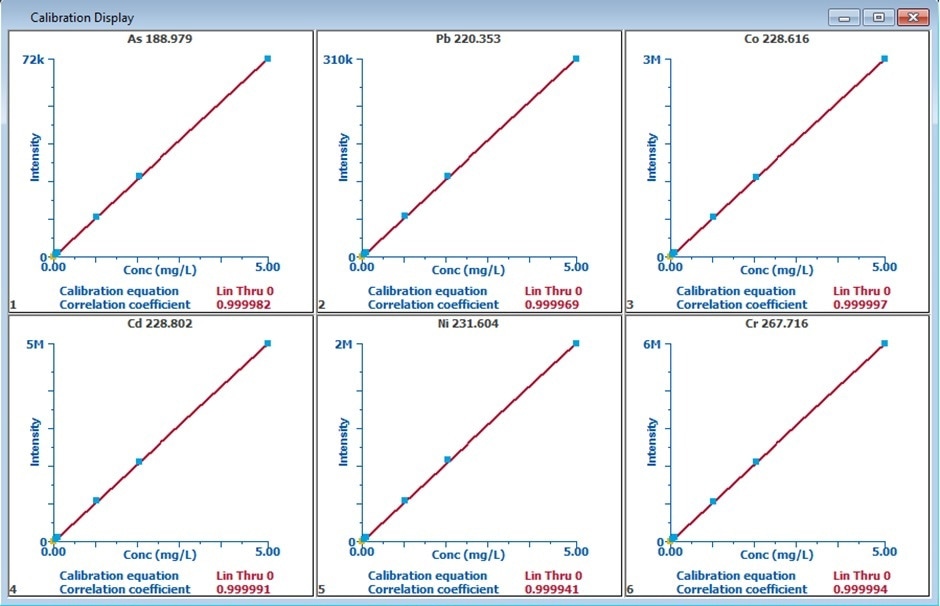The main benefit of fertilizer lies in increasing crop productivity. Fertilizer production is a key industry for the agricultural sector of a country. The major elements of interest in fertilizers are classified as: primary nutrients, secondary nutrients, micronutrients, and trace elements. The representative elements in each of these classes are shown in Table 1.

Table 1. Elemental Categories in Fertilizer
| Class |
Elements |
| Primary Nutrients |
N, P, K |
| Secondary Nutrients |
Ca, Mg, Fe, Mn, Cu, Zn, Mo, B, S |
| Micronutrients |
Al, Co, V, Se, Ni |
| Trace Elements |
As, Cd, Cr, Pb |
Chemical fertilizers are widely utilized in agriculture at present, and this has led to increased demand for them. However, this demand has also led to the production of some inferior quality fertilizers. The primary and secondary nutrients and the trace elements need to be analyzed and monitored to ensure that the fertilizers' quality conforms to local regulations. The Thailand Agricultural Department’s regulatory levels of the trace elements present in fertilizers is listed in Table 2. Although various techniques may be employed to measure trace elements in fertilizer, ICP-OES provides the best combination of simplicity, cost, accuracy, and ruggedness. The ICP-OES also has a dynamic range which is suitable for the concentrations expected in fertilizer samples.
Table 2. Regulatory Limits of Elements in Fertilizers in Thailand
| Element |
Regulatory Concentration (mg/kg) |
| As |
50 |
| Cd |
5 |
| Cr |
300 |
| Pb |
500 |
This article shows the ability of the Avio™ 200 ICP-OES to satisfy the Thai regulatory limits for trace elements in fertilizers by the analysis of reference materials.
Experimental Conditions
Samples and Sample Preparation
The method was validated using two reference materials: BCR-032 Trace Elements in Moroccan Phosphate Rock and NIST 695 Trace Elements in Multi-Nutrient Fertilizer. The first reference material was chosen as it has a high phosphate concentration comparable to the high phosphorus concentrations commonly seen in fertilizers.
The Titan® MPS Microwave digestion system was employed to prepare the samples by microwave digestion. 0.15 g of sample was added to each vessel, after which 6 mL concentrated nitric acid and 2 mL concentrated hydrochloric acid were also added. The vessels were left uncovered for 10 minutes in order to allow any early safe reactions to occur. Then the vessels were capped, kept in the Titan®, and digested using the temperature program, as shown in Table 3. After digestion, the samples were shifted to 100 mL volumetric flasks, and 100 mL of deionized water was used for dilution in performing the analysis.
Table 3. Titan MPS Temperature program
| Temperature Program |
| Step |
Target Temp (°C) |
Pressure Limit (bar) |
Ramp Time (minutes) |
Hold Time (minutes) |
Power (%) |
| 1 |
160 |
30 |
5 |
5 |
90 |
| 2 |
180 |
35 |
2 |
30 |
100 |
| 3 |
50 |
35 |
1 |
15 |
0 |
| 4 |
- |
- |
- |
- |
- |
Instrumental Parameters
The Avio™ 200 was used to analyze all samples by using the parameters given in Table 4, including the standard sample introduction system. Thanks to Avio’s Flat Plate plasma technology, only 9 L/min of argon was used. The plasma technology along the vertical torch improves the ability to analyze high-matrix samples. Table 5 shows the wavelengths and analytes. All quantitative measurements were carried out against external calibration curves constructed from 0.05, 0.1, 1, 2, and 5 ppm standards.
Table 4. Instrumental parameters and sample introduction components for Avio™ 200 ICP-OES
| Parameter |
Value |
| Nebulizer/spray chamber |
Meinhard/Cyclonic |
| Injector |
Alumina Injector 2.0 |
| Read Time |
1 sec (min) – 2 sec (max) |
| Plasma Gas |
8 L/min |
| Auxiliary Gas |
0.2 L/min |
| Nebulizer Gas |
0.7 L/min |
| Power |
1400 W |
| Plasma View |
Axial |
Table 5. Elements and Wavelengths
| Elements |
Wavelength (nm) |
Plasma View |
| Arsenic (As) |
188.979 |
Axial |
| Lead (Pb) |
220.353 |
Axial |
| Cobalt (Co) |
228.616 |
Axial |
| Cadmium (Cd) |
228.802 |
Axial |
| Nickel (Ni) |
231.604 |
Axial |
| Chromium (Cr) |
267.716 |
Axial |
Results
The reference materials were measured to determine the method accuracy. Initially, calibration curves were established, which are illustrated in Figure 1. In all the curves, the correlation coefficients are greater than 0.9999. Tables 6 and 7 show the results for the reference materials for NIST 695 and BCR-032, respectively. The tables demonstrate the accuracy of the technique as all recoveries are within 10% of the certified values.

Figure 1. Calibration curve for all elements.
Table 6. Result of SRM 695
| Analyte |
Certified Values (mg/kg) |
AVIO™ 200 Values (mg/kg) |
% Recovery |
| As |
200 |
211 |
107 |
| Pb |
273 |
295 |
108 |
| Co |
65.3 |
62.9 |
96 |
| Cd |
16.9 |
18.0 |
107 |
| Ni |
135 |
139 |
103 |
| Cr |
244 |
243 |
100 |
Table 7. Result of CRM BCR-032
| Analyte |
Certified Values (mg/kg) |
AVIO™ 200 Values (mg/kg) |
% Recovery |
| As |
9.5 |
< DL |
- |
| Pb |
5.4 |
< DL |
- |
| Co |
0.59 |
0.613 |
104 |
| Cd |
20.8 |
21.8 |
105 |
| Ni |
34.6 |
35.0 |
101 |
| Cr |
257 |
261 |
102 |
The detection limits (DLs) of this technique were calculated by analyzing a matrix blank. The matrix blank contained the same reagents and quantities as those employed for sample preparation. The DLs were calculated by multiplying the standard deviation of ten replicate measurements by three (Table 8).
Table 8. Detection Limits in Fertilizer Samples
| Analyte |
DLs (mg/kg) |
Thai Regulated Levels (mg/kg) |
| As |
3.01 |
50 |
| Pb |
3.37 |
500 |
| Co |
0.31 |
Not specified |
| Cd |
0.21 |
5 |
| Ni |
0.59 |
Not specified |
| Cr |
0.79 |
300 |
Conclusion
This article has shown the ability of the Avio™ 200 ICP-OES to accurately measure trace elements and secondary nutrients present in fertilizers at or below the regulated levels in Thailand.
Consumables Used
| Avio™ 200 ICP-OES |
| Component |
Part Number |
| Red-Red PVC Pump Tubing |
09908585 |
| Black-Black PVC Pump Tubing |
09908587 |
| Autosampler Tubes |
B0193233 (15 mL)
B0193234 (50 mL) |
| PerkinElmer Pure XVI (QC 21 Elements) |
N93002812 (125 mL) |
| Titan® MPS Microwave |
| Component |
Part Number |
| Consumable Kit for Standard 75 mL Digestion Vessels |
N3132000 |
| Rupture Disks for Standard 75 mL Digestion Vessels (25 pieces) |
N3132001 |
| Pressure Seal for Standard 75 mL Digestion Vessels (10 pieces) |
N3132002 |
| End Cap Plug for Gas Containment Manifold |
N3134004 |
| Single Lip Seal Forming Tool for Standard 75 mL Digestion Vessels |
N3132015 |
| 8-Position Lip Seal Forming Tool for Standard 75 mL Digestion Vessels |
N3132014 |

This information has been sourced, reviewed and adapted from materials provided by PerkinElmer Inc.
For more information on this source, please visit PerkinElmer Inc.